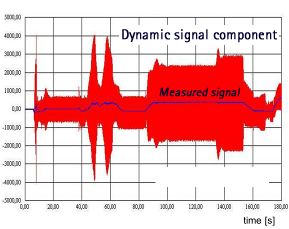Drawbacks of the indirect method
Torque measurement using a force transducer
Determining torque through reaction torque measurement using a force transducer - e.g. a self-aligning brake (see Fig. 1) - requires complicated mechanics. Interference effects such as variations in the self-aligning brake over time or expansion of the lever arm resulting from temperature variations need to be taken into account; otherwise they may cause measurement errors.
Furthermore, this method is not suitable for dynamic tests because of the large masses involved, since they virtually act as a "mechanical low pass" (see Fig. 2).
Determination via auxiliary quantities
When determining the measurand torque using auxiliary quantities, for example, strain and torsion angle, it is essential to allow for individual errors resulting from diameter and input shaft length tolerances or from a measurement error in the torsion angle. In addition, errors resulting from lacking or limited temperature compensation need to be taken into account when applying these measurement methods.

